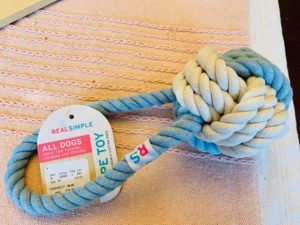Death from a seemingly harmless toy can strike fear in any dog owner. In this tragic case, a beloved Golden Retriever, Sam, lost her life after ingesting parts of a rope toy that unraveled inside her body, causing severe internal damage. Despite emergency surgery to remove the rope and perforated intestines, she sadly succumbed to complications just two days later. This incident highlights the importance of understanding the dangers of such toys and the urgent need for awareness among pet owners to prevent similar tragedies.
The Incident
A tragic event unfolded when Indria Tuckler, a dedicated Golden Retriever owner, discovered that her beloved dog, Sam, had ingested dangerous pieces of a rope toy. After a short time of play, the seemingly safe toy led to devastating internal injuries, resulting in Sam’s untimely death just two days later. The heart-wrenching journey underscored the hidden dangers of toys often considered benign by pet owners.
Background of Indria Tuckler
Incident began with Indria Tuckler, who was not only a passionate dog owner but also a Golden Retriever breeder. She invested considerable time and love in caring for her dogs, highlighting the bond she shared with her furry companions. This deep commitment made the loss of her young dog, Sam, all the more profound.
Purchase of Rope Toy
Across pet stores and retail chains, rope toys are marketed as durable playthings for dogs. However, many owners, like Indria, trust these products without being aware of potential dangers. In her case, several rope toy balls were purchased from a local Home Goods store, believed to be safe for her dogs. This choice ultimately led to a devastating series of events, highlighting a serious need for greater awareness around the safety of such toys.
In addition, many dog owners may overlook the fact that these toys can unravel within hours, posing significant risks. Many pet stores, including major chains like PetSmart and Petco, continue to sell these products, further increasing the likelihood of similar incidents occurring. Symptoms of ingestion can often be mistaken for other illnesses, making it challenging for pet owners to act quickly. Understanding the hidden dangers of rope toys is vital, as they can cause severe internal damage that is not easily diagnosed through standard imaging techniques.
The Tragic Outcome
Some dogs face dire consequences from seemingly innocent toys. This was tragically the case for Sam, Indria Tuckler’s cherished Golden Retriever. After ingesting pieces of a rope toy, she suffered severe internal damage that led to her untimely death just two days later. Despite the owner’s efforts to provide a safe play experience, what seemed like simple playtime turned deadly due to the inherent risks of rope toys.
Sam’s Symptoms
Across her final days, Sam exhibited concerning symptoms that were easily mistaken for other ailments. She experienced vomiting, diarrhea, excessive thirst, and a noticeable loss of appetite—signs that ultimately masked the underlying danger posed by the ingested rope fibers.
Emergency Surgery
Around the clock, veterinarians performed an emergency surgery to save Sam’s life, discovering the grave extent of her condition. They had to remove three feet of rope and a significant portion of her intestines, approximately 14 inches, in hopes of preventing further complications.
Hence, the surgery was extensive and aimed at addressing the severe internal injuries caused by the rope. Despite the intervention, the situation was dire; Sam developed sepsis and began to bleed internally. The infection spread rapidly, ultimately leading to a heartbreaking outcome. Their efforts underscored the profound risks associated with rope toys, and the procedure, while necessary, did not guarantee her survival. This tragic experience serves as a significant warning to all dog owners about the hidden dangers these toys can pose.
Understanding the Dangers
Any dog owner should be aware of the associated risks when it comes to seemingly innocent toys, especially rope toys. These products, often deemed safe and durable, can pose life-threatening hazards to dogs, as evidenced by the heartbreaking case of a young Golden Retriever who tragically lost her life after ingesting pieces of such a toy. The lax safety standards surrounding these products leave many pet owners unaware of the potential dangers lurking within their dog’s playtime.

Risks Associated with Rope Toys
Behind their playful appearance, rope toys can cause severe internal damage if ingested. The fibers tend to unravel quickly, leading to potentially lethal consequences for dogs. Veterinary professionals have noted that rope fibers act like a “saw” inside a dog’s digestive tract, resulting in lacerations and internal bleeding. The danger is amplified as these fibers are often undetectable on X-rays, complicating diagnosis and timely treatment.
Common Symptoms of Ingestion
Beside the immediate concern of ingestion, dog owners must recognize the common symptoms that can indicate a serious issue. Signs such as vomiting, diarrhea, excessive thirst, and loss of appetite may initially appear benign, but they can signify internal distress caused by swallowed rope fibers. It is vital for pet owners to remain vigilant; interpreting these symptoms as life-threatening before they escalate is vital for ensuring timely veterinary intervention.
Commonly, when dogs ingest rope toy fibers, these symptoms may be misattributed to other illnesses, delaying necessary medical care. Timely recognition of these signs can be life-saving. Given the tragic experience shared by the dog owner Indria, it’s imperative that pet owners take these indicators seriously, as the consequence of inaction can lead to devastating outcomes like those suffered by the Golden Retriever, who faced a fatal battle against internal injuries.
Veterinary Insights
Once again, the tragic case of Sam the Golden Retriever highlights the dangers posed by seemingly innocent rope toys. Veterinarians emphasize the significant risks associated with these toys, as they can lead to severe internal injuries if ingested. As pet owners choose toys for their dogs, they must remain informed about the potential hazards that could result in heartbreaking scenarios similar to Sam’s.
Challenges in Diagnosing Ingestion
Diagnosing the ingestion of rope toys poses unique challenges for veterinarians. Symptoms such as vomiting, diarrhea, and loss of appetite can be misattributed to less severe conditions. Additionally, rope fibers are not visible on X-rays, complicating the diagnostic process and delaying necessary surgical intervention.
Preventive Measures
On the topic of preventing ingestion, pet owners are encouraged to take proactive steps when selecting toys for their dogs. Understanding the risks associated with rope toys can lead to better choices and safer playtime for pets.
Indeed, it is vital for dog owners to actively seek out safe alternatives to rope toys, such as durable rubber toys or plush options specifically designed for chewing. Regularly inspecting toys for wear and tear can help mitigate risks, along with closely monitoring their pets during playtime. By choosing safe toys and educating themselves about the signs of potential ingestion, owners can play a vital role in safeguarding their furry companions from the dangers of harmful toys.
Raising Awareness
Not all toys marketed for dogs are safe. The tragic loss of Sam, Indria Tuckler’s Golden Retriever, illustrates the hidden dangers of rope toys that can lead to severe internal injuries and even death. Indria’s story serves as a vital reminder that vigilance in toy selection is imperative for every dog owner’s peace of mind.
Indria’s Plea to Dog Owners
To prevent other dog owners from experiencing similar heartbreak, Indria is urging them to share her warning far and wide. She believes that raising awareness about the inherent risks associated with rope toys can genuinely save lives, stressing that vigilance is necessary in choosing safe playthings for their pets.
Importance of Safe Toy Choices
A responsible toy choice can significantly reduce the risk of serious injuries. Around 15% of pet owners report their dogs have experienced health issues due to unsafe toys. Indria’s plea highlights that symptoms of ingestion—like vomiting and diarrhea—can easily be mistaken for other issues, making early detection difficult. Safeguarding pets involves opting for toys specifically designed to be non-toxic and rupture-resistant, while avoiding those that unravel or pose choking hazards.
The Impact of Rope Toys
Unlike other dog toys, rope toys pose serious threats to a dog’s health due to their tendency to unravel. Indria Tuckler’s heartbreaking experience with her Golden Retriever, Sam, highlights the severe internal damage these toys can cause, leading to costly medical interventions and, in tragic cases, loss of life.
Historical Cases
Alongside Indria’s story, many dog owners have reported similar incidents where their pets faced severe health consequences after ingesting rope fibers. These cases reflect a growing concern among pet owners and veterinarians about the safety of rope toys.
Recommendations from Veterinarians
By addressing the dangers of rope toys, veterinarians strongly advise pet owners to seek safer alternatives. They recommend toys made from durable, non-fraying materials that eliminate the risk of ingestion and internal harm.
A significant body of veterinary advice underscores the importance of choosing pet toys wisely. Many veterinarians urge owners to avoid rope toys altogether, emphasizing that these toys can quickly unravel, posing life-threatening risks. The fibers act like dangerous “saws” inside a dog’s digestive tract, potentially leading to severe lacerations and internal bleeding. Veterinarians recommend opting for toys specifically designed with safety in mind, as they can significantly reduce the risk of gastrointestinal emergencies. Providing proper alternatives ensures pets can play safely and healthily, preventing unnecessary suffering and heartache.
Dog Owner Posts “Heartbreaking Warning” After Golden Retriever Dies From Rope Toy
 wagwagtail "only love can make your dog wag her tail"
wagwagtail "only love can make your dog wag her tail"
